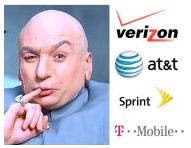Don’t Leave Money on the Table
When choosing a wireless plan for your business, there are a wide range of factors that will affect what you get and how much you pay. You should consider factors like amount of talk time, how you will divvy up available time, penalties for exceeding allotted allowance (called “overage”), and types of calls made. There may be situations where unlimited usage is ideal or where you might be better off with “pay as you go” pricing or a seasonal option.

Credit: deadzones.com
You might be surprised to know that often the rate quoted to you by a wireless carrier is not the most cost effective rate for your business. In fact, wireless providers are only required to quote you a “correct rate,” (one that actually exists in their approved rates), but not necessarily the rate plan that is best for you.
When reviewing our client cellular invoice data we often find situations where the most cost effective option is not the most obvious, and may even seem counter intuitive. For example, a unit with high usage using 2,500 minutes/month (150 peak/anytime, 75 mobile/mobile, and 2,275 night/weekend) on an $80 unlimited plan seems logical. However, the same service can be obtained at a fraction of the cost with a plan priced at $45/month with 400 minutes and unlimited night/weekend usage.
With wireless plan options becoming more complex these are the types of questions you should be asking when choosing a cellular rate plan that works for your business without leaving money on the table.
When evaluating wireless needs, two important questions are:
- How much usage allowance do I need?
- Is my cost fixed or will it fluctuate each month?
To elaborate, consider the following 6 factors:
1. How many minutes are needed, per phone or group of phones?
Determining the allowance for all of the wireless phones on the plan is an essential step in choosing the most cost effective option for your business. There may very well be some units that use far more (or less) minutes than the rest of the units in the plan. The question then becomes, how do you account for this in the overall allowance decision?
A common practice among businesses now is pooling minutes, in which you buy an allowance to be used across all units on the plan. This is usually the best way to maximize savings and makes it vastly easier to budget the expense. Before you jump into a pooling plan however, be sure to look into billing data to determine if there are units with usage in either extreme that should be kept on their own plans.
2. What is the range of usage?
When determining the most beneficial wireless plan for your organization you must look into past usage patterns to estimate future usage and estimate what you will need.
It is critical to identify what a typical month looks like across all units and to identify any months that are particularly high or low in usage. By identifying these factors you can average out an allowance that makes sense for all of the months throughout the year while still keeping monthly cost as low as possible.
Another critical element here is identifying the types of usage available in your plan options. Minutes for different types of usage (i.e. anytime, incoming, mobile to mobile, and nights/weekends) may not be included in pool selections with lower total minutes, leaving you with extra usage charges. If your business has units with usage uncommon to most of the units in the plan, then it may make sense to keep those units on their own separate plans.
3. How often do spikes in usage occur?
 Spikes in usage will happen, usually because of some type of seasonality. If the spikes are large enough there may be some questions you’ll want to address when purchasing your plan.
Spikes in usage will happen, usually because of some type of seasonality. If the spikes are large enough there may be some questions you’ll want to address when purchasing your plan.
The first question is undoubtedly whether to account for the spikes in pool selection and allowance for all units. There may be some units for which it may make sense to keep on their own separate plans, depending on how many minutes they use, as well as when they use them.
In some cases, as with seasonal employees, it is more cost effective to have them on pay-as-you-go plans that don’t take from your pool allowance. Many carriers also have seasonal options available that allow you to keep your phone number and deactivate the unit during the off season. These devices can be put into use throughout the year as spikes occur. Activation fees may apply and should also be considered.
4. What is the rate/minute cost after allowance?
When taking into consideration usage spikes you will want to know what the rate per minute after allowance will be. That is, if you do go over your allowance for the pool, what will you pay per minute overage?
This is a question of risk. The cost of overage on most plans ranges from $.25 to $.45 per minute. What is the risk of keeping units that occasionally exceed average usage levels of phones in the pool? If the overage isn’t significant and there are phones in the pool that typically use less than the average amount of minutes, risk of breaching the allowance is low. It is the cases in which usage is consistent that looking at how a plan is constructed becomes much more practical in terms of cost.
5. What features are available and what features, if any, are needed?
 A feature is considered anything you add on to your plan. Determining what features your people need to operate in the field is essential, but choosing how you pay for them is just as important as minutes of usage when determining the most cost effective wireless plan.
A feature is considered anything you add on to your plan. Determining what features your people need to operate in the field is essential, but choosing how you pay for them is just as important as minutes of usage when determining the most cost effective wireless plan.
One of the most common features added to a unit is unlimited text messaging. It sounds like a good deal, but when you look into usage data you may find that units with unlimited texting don’t actually text enough to warrant the expense. Identifying these units is important because unlimited texting can be a costly feature per unit.
The cost per text message typically ranges from $.02 to $.20 per message. Be sure to identify the cost per text for your wireless provider, look into usage data, and determine if it may be more cost effective to reduce texting allowance, or eliminate it entirely and pay a la carte.
6. When upgrading equipment, what additional costs will you incur?
It is common when upgrading equipment to incur added costs due to additional features required by the new device. The prime example here is the upgrade to a smartphone from a ‘basic’ phone.
Any smartphone will require a data plan, even if the unit doesn’t use data. By making an upgrade in this situation you could be looking at an increase in monthly fees for features that may not provide any added benefit if the user of the unit has no need for the new capabilities of the upgraded phone.
If the only reason for an upgrade is for appearance, it may make sense to keep current equipment. Of course, should the monetary value of appearance be significant enough, the decision is always up to management. Just keep in mind the potential savings of choosing to hold off on an unnecessary upgrade.
These six factors only scratch the surface of things to identify, consider and possibly change when constructing the most cost effective wireless plan for your business. Every business has different needs and methods of operation, and it’s important to ascertain if your wireless plan best fits those needs. More often than not it doesn’t, and there is a better, more cost effective way to purchase from your wireless provider, all you have to do is look.
